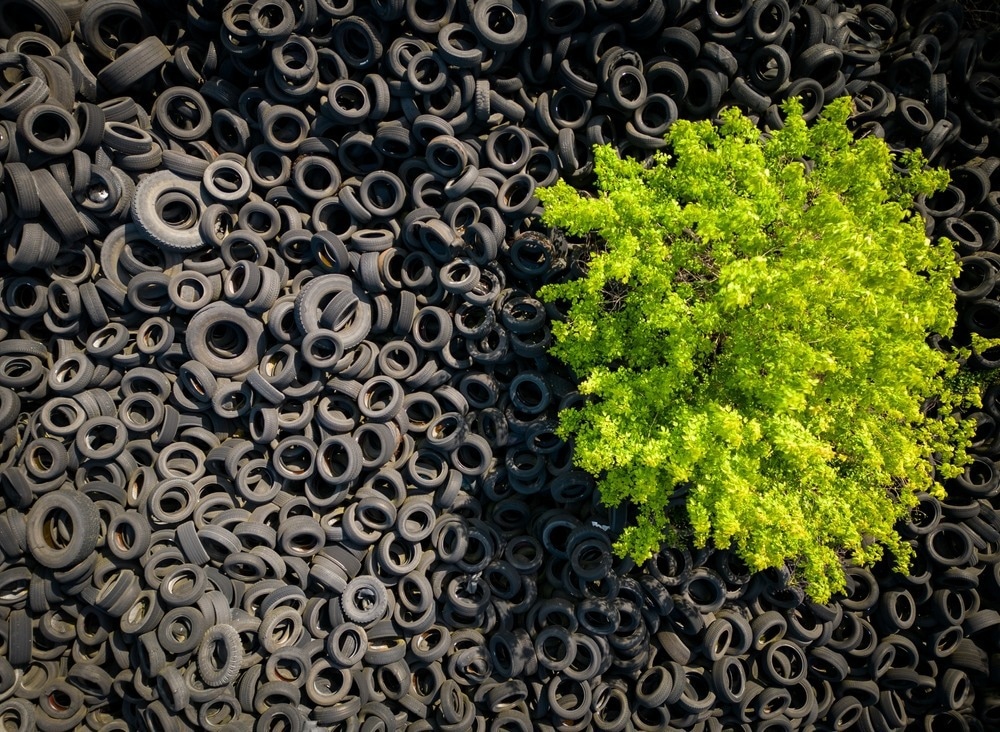 By Taha KhanReviewed by Lexie CornerApr 15 2024
By Taha KhanReviewed by Lexie CornerApr 15 2024The world is moving rapidly toward adopting sustainable energy solutions to tackle climate change and other environmental issues posed by the excessive use of conventional energy sources like fossil fuels. In this regard, there is also a growing demand for sustainable and efficient energy storage devices.

Image Credit: sandsun/Shutterstock.com
However, attaining such an efficient energy storage system faces several challenges. Thus, innovation in materials science is crucial for developing the next generation of energy storage systems.
This article discusses how rubber could be one of these promising materials in overcoming these challenges.
The Essentials of Energy Storage Systems
Energy storage systems are of central importance for sustainable or renewable energy sources, such as solar and wind power, enabling their use when demand is high or when renewable energy production is low. Various energy storage systems, like batteries and supercapacitors, are available, each with unique strengths and weaknesses.1
The choice of materials used in each storage system depends on specific properties, including thermal stability, flexibility, and durability. Since the energy storage process often generates heat, which can degrade components, the material used in energy storage systems should withstand these thermal fluctuations.2
Similarly, energy storage systems undergo repeated charge-discharge cycles that can cause pressure fluctuations in devices like batteries; hence, using a durable material is important to ensure long-term performance.
Rubber in the Heart of Innovation
Rubber possesses unique properties, including thermal resistance, electrical insulation, and chemical stability, making it an appealing candidate for various components within energy storage systems.
For instance, rubber is an excellent insulating material and a leakage-preventing seal in supercapacitors and batteries, helping to maintain electrical integrity while providing flexibility and design versatility.
Natural rubber-based electrolytes are also used in supercapacitors that offer more suitable and cost-effective solutions compared to their conventional counterparts.3, 4 Rubber-based flexible components are used in solar panels, enabling them to adapt to different environments and applications.5
Natural Rubber-Based Electrolyte Innovation
In a 2023 study, researchers developed a novel supercapacitor using methyl-grafted natural rubber (MG49-NR) for the electrolyte and natural graphite (NG) composite electrodes.
The electrolyte consists of zinc trifluoromethanesulfonate (Zn(CF3SO3)2) salt blended with MG49-NR, showing promising solvation characteristics. Characterization via ATR-FTIR and XRD confirmed the successful integration of the salt into the polymer matrix.4
The fabricated supercapacitor exhibited dominant capacitive behavior at low frequencies with a specific capacitance (Csc) of 4.2 Fg−1. Although initial capacitance declined rapidly, stabilizing after 2500 cycles, energy and power densities remained within acceptable ranges.
Despite lower performance compared to some supercapacitors, this study highlights the potential of utilizing natural rubber-based electrolytes and NG electrodes, offering a sustainable and cost-effective alternative and innovative rubber technology for energy storage.4
Challenges and Solutions
Several challenges hinder the utility of rubber energy storage solutions, including material degradation issues, cost-effectiveness, and manufacturing complexities.
For instance, exposure to extreme temperatures and ultraviolet radiation causes the rubber to degrade over time, necessitating the development of new rubber compounds with enhanced resistance to these stressors.
However, developing such specific rubber formulations needed for energy storage applications might require specialized manufacturing processes, potentially impacting overall cost, making developing cost-efficient techniques an absolute imperative.6, 7
Novel Rubber-Based Battery Material
Implementing rubber into complex energy storage systems can present unique manufacturing challenges in developing rubber-based materials that have enhanced properties for energy storage applications but also maintain the inherited properties of rubber, like mechanical durability.
For instance, in a 2022 study, researchers developed a novel rubber-based material for use in batteries, addressing the challenge of low ionic conductivity while maintaining mechanical durability. By vulcanizing nitrile butadiene rubber (NBR) with a polymerizable ionic liquid (IBIL), a lithium-conducting elastomer with high resilience and enhanced ionic conductivity was achieved.7
This elastomer exhibited remarkable properties, including a resilience of 0.92 MJ m−3, cyclic durability of 1000 cycles at 50 % strain, and a room-temperature ionic conductivity of 2.7 × 10−4 S cm−1. These characteristics enabled stable interfacial contact and fast lithium-ion transport, resulting in high-performance solid-state lithium metal batteries with long cycling life and capacity retention.
This innovative approach offers promise for developing rubber-derived elastomers with tailored mechanical properties and enhanced ionic conductivity for practical battery applications.7
Future Perspectives
In the future, through continuous research and development in material science and engineering, scientists and engineers are expected to make significant progress in enhancing the performance, efficiency, and sustainability of energy storage systems.
Rubber-based systems are crucial in energy storage devices like supercapacitors and batteries due to their versatility, reliability, eco-friendly nature, thermal resistance, and flexibility.
Recent studies highlight the potential of natural rubber-based electrolytes and novel rubber-based materials in improving energy storage performance.4, 7
Despite challenges, rubber-based materials with tailored properties have great potential to deliver next-generation energy storage solutions, contributing significantly to the global transition toward sustainable energy practices.
More from AZoM: How are Advanced Energy Storage Materials Used in Solar Desalination?
References and Further Reading
- Amrouche, SO., Rekioua, D., Rekioua, T., Bacha, S. (2016). Overview of energy storage in renewable energy systems. International journal of hydrogen energy. doi.org/10.1016/j.ijhydene.2016.06.243
- Wang, X., Lu, X., Liu, B., Chen, D., Tong, Y., Shen, G. (2014). Flexible energy‐storage devices: design consideration and recent progress. Advanced materials. doi.org/10.1002/adma.201400910
- Chen, J., Wang, Y., Chen, W. (2021). Excellent comprehensive energy storage capabilities achieved in linear polymer composites via inserting acrylic rubber dielectric elastomers. Journal of Materials Chemistry C. doi.org/10.1039/D0TC05874B
- Perera, KS., Vidanapathirana, KP., Adams, LJ., Balakrishnan, N. (2023). Sustainable supercapacitor with a natural rubber‐based electrolyte and natural graphite‐based electrodes. Electrochemical Science Advances. doi.org/10.1002/elsa.202300025
- Sola Racks (no date). How is EPDM used in solar mounting system. [Online] Sola Racks. Available at: https://www.solaracks.com/how-is-epdm-used-in-solar-mounting-system/ (Accessed on 2 March 2024)
- Rajapaksha, HGN., Perera, KS., Vidanapathurana, KP. (2021). Novel study on a safe, low-cost natural rubber: Mg-based solid polymer electrolyte for energy storage. Journal of Rubber Research. doi.org/10.1007/s42464-021-00132-5
- Shi, Y., Yang, N., Niu, J., Yang, S., Wang, F. (2022). A highly durable rubber‐derived lithium‐conducting elastomer for lithium metal batteries. Advanced Science. doi.org/10.1002/advs.202200553
Disclaimer: The views expressed here are those of the author expressed in their private capacity and do not necessarily represent the views of AZoM.com Limited T/A AZoNetwork the owner and operator of this website. This disclaimer forms part of the Terms and conditions of use of this website.